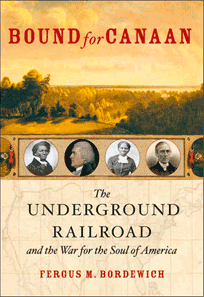
EXCERPTS: From The Intro
REVIEWS: Wall street Journal | Publisher’s Weekly | New Yorker | American Heritage | Civil War History | The Smithsonian | Kliatt | the Washington Post | the afrolumens project | the atlantic
Review: The New Yorker
IN THE FIRST years of the nineteenth century, most runaway slaves didn't get very far: ‘Slave holders sought to impress their slaves with a belief in the boundlessness of slave territory,’ Frederick Douglass wrote, and, given the reach of fugitive slave laws, ‘the real distance was great enough.’ Those who did make it almost always had the help of Quakers, free blacks, and other opponents of slavery, who composed what Bordewich calls a ‘national geography of freedom.’
This engrossing account of the Underground Railroad describes how scattered ‘experimental, impulsive’ acts (for instance, defending a fugitive from a patrol) became an organized operation involving thousands of stationmasters, conductors, and spies. Some of the less known, and more remarkable, stories here involve the blacks workers on the Railroad, such as Arnold Gragston, who, while remaining a slave, ferried hundreds of runaways across the Ohio River until 1863, when he became his own last passenger.

